After two months in Belgium, Mark, Maya, and I passed through Massachusetts (USA) for another week. To deal with dog Maya’s export paperwork, to visit family and friends, to pick up heaps of gear and parts, and to spend two days at the dentist for me. Something that wasn’t planned before we booked our flights.
Here is my dental story, which might help some people but bore others to death. You have been warned.
The past
As a child and teenager in Belgium, I was taught to brush my teeth twice a day. After breakfast and before bedtime. My parents were adamant about that schedule and took us to the dentist as needed.
As an adult, I stuck to the twice-a-day brushing and added flossing to my evening routine. In the US, I discovered tongue scrapers, more a breath improvement than a dental one. I learned about teeth cleaning, too. In Belgium, my dentist always remarked how well I brushed my teeth and no plaque was found to remove. When I became a US citizen, I attended yearly cleanings.
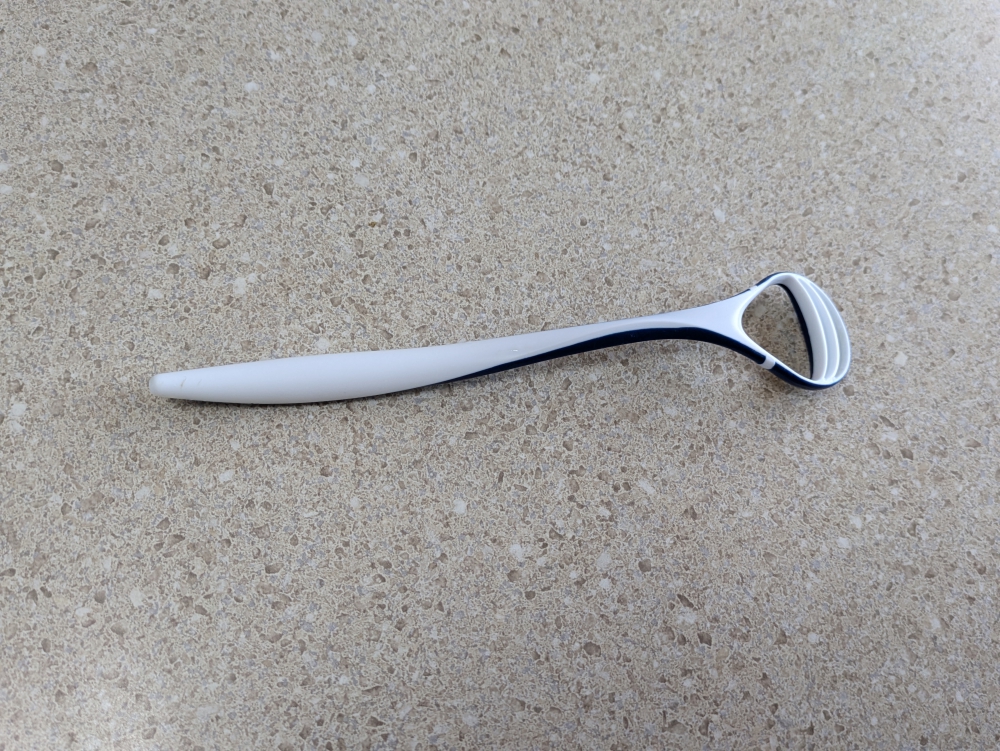
My trusted tongue scraper
My MassHealth insurance plan covers dentist visits, but doesn’t offer the greatest selection of dental clinics, so I’ve enrolled and “derolled” as a patient three times in the last decade. Since I didn’t return to the US in 2023, I skipped my annual teeth cleaning, so went without help for two years. Not a good idea!
The present
Mark and I found a new dentist this past summer and he appeared to be a caring, meticulous, and professional one. Mark had his cleaning done – in and out within an hour – and my appointment took place the week before Independence Day. What was supposed to be a routine check-up and cleaning turned out quite differently. Plus, I was leaving to Belgium ten days later.
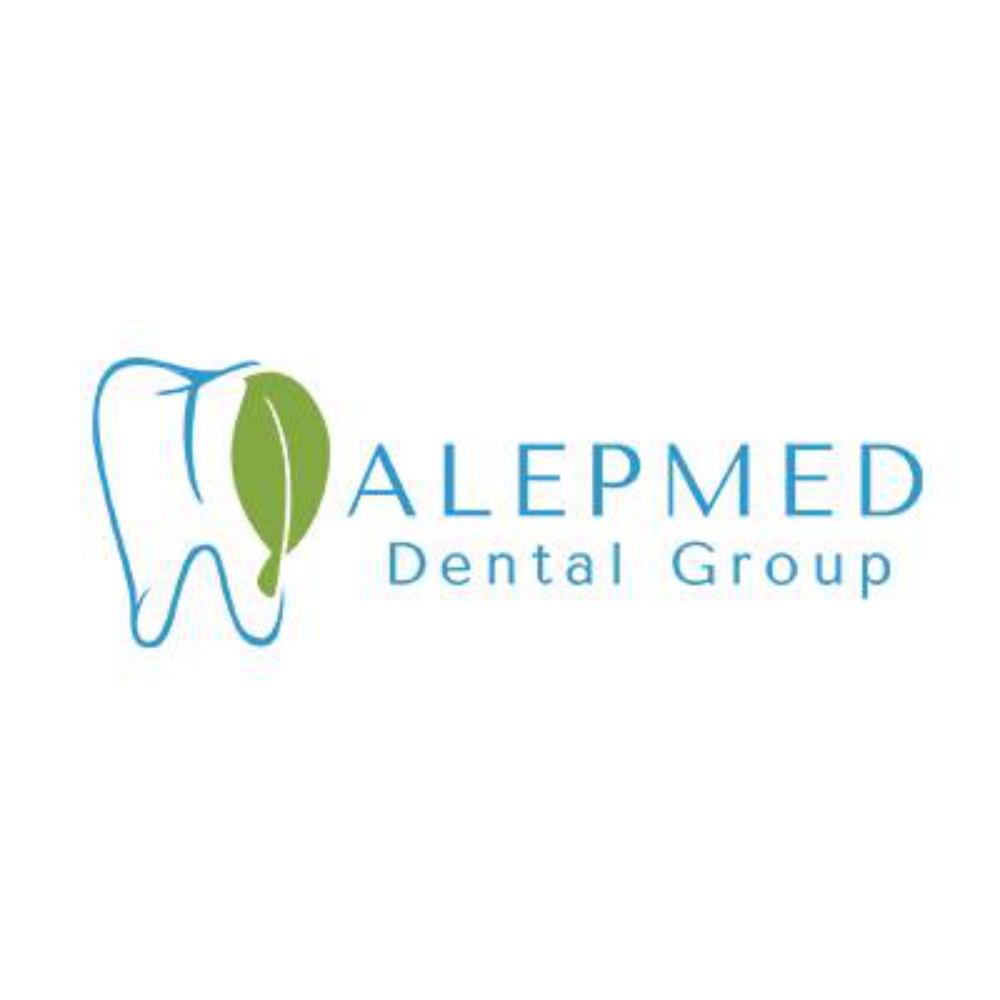
Alepmed Dental Group – my new dental clinic
Like any new patient, I had scans taken and slides for X-rays jammed between my sensitive gums. At least twenty of them. Gag reflex, anyone?
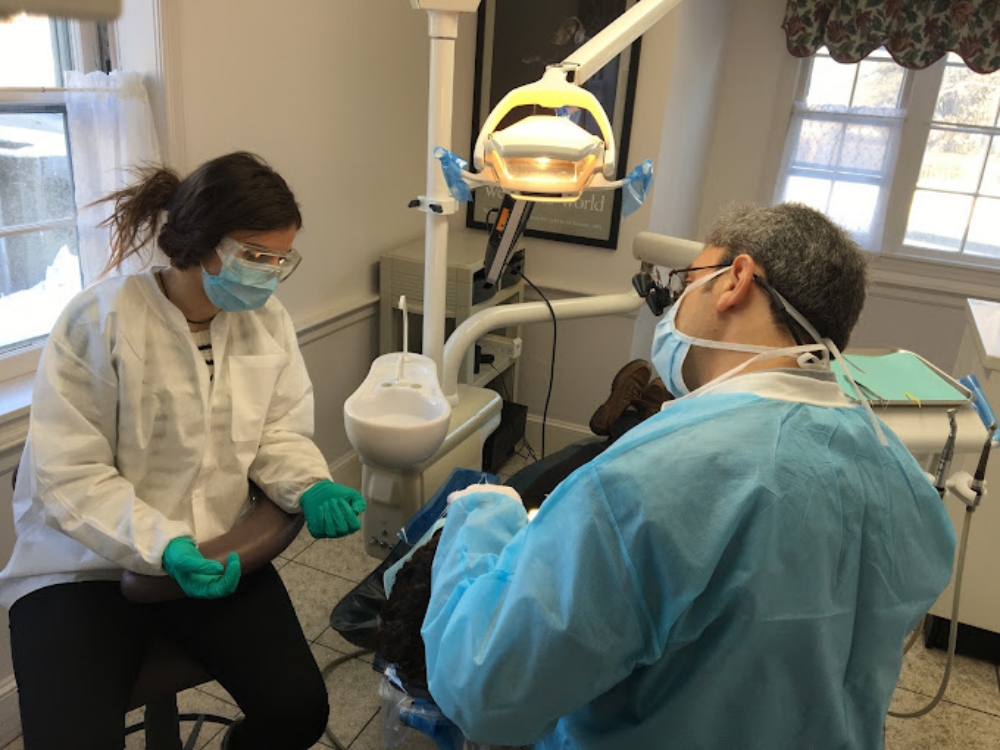
Dr. John and an assistant at work
A quick exam followed, with an in-depth discussion. There was no more time for the cleaning. But what I learned was horrifying: I had severe bone loss and extensive gum disease (periodontitis). I was at risk of losing nine teeth. And, I had seven cavities, four of which needed to get fixed with crowns. To say I was stunned is an understatement.
FYI: Almost half (47.2%) of all adults aged 30 years and older have some form of gum or periodontal disease. Only the first stage of gum disease, known as “gingivitis” can be reversed. After it progresses into the second stage (periodontitis), it’s no longer possible to completely eliminate it.
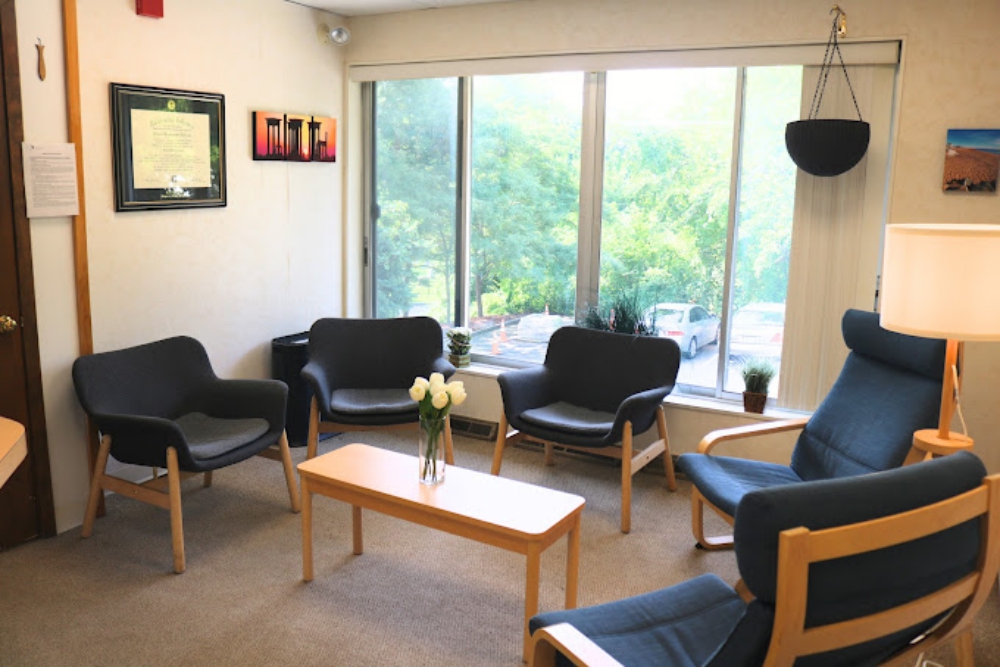
Waiting room
The following day, the dental practice fit me in throughout the morning. I received a deep and painful cleaning, more chats with the dentist, and three fillings. Still four crowns to go, ideally soon, and – hopefully – root scaling to improve the deep pockets in my gums, once I returned from Belgium.

The dentist committed to taking care of me on the eve of the Fourth of July long weekend and one of his assistants agreed to work overtime as well. The pair handled my mouth for three hours straight, to fix five cavities and to shave off, clean, and prepare five – not four – teeth for crowns. Without numbing. To say it was a painful evening is an understatement. It was on par with my migraines.
Yet, they managed to make imprints for the five crowns to send to the lab and they provided me with temporary crowns and antibiotics by 8pm.
The next issue? Temporary crowns are supposed to last for two weeks, until the permanent ones show up. I’d be out of the country for nine weeks!
By then, the dentist and hygienist had also convinced me to change my dental routine: to use an electric brush instead of a manual one (check), to invest in a water flosser (check), to brush after every meal (check). He also recommended I’d still use the string floss and alternate with a manual brush once in a while.
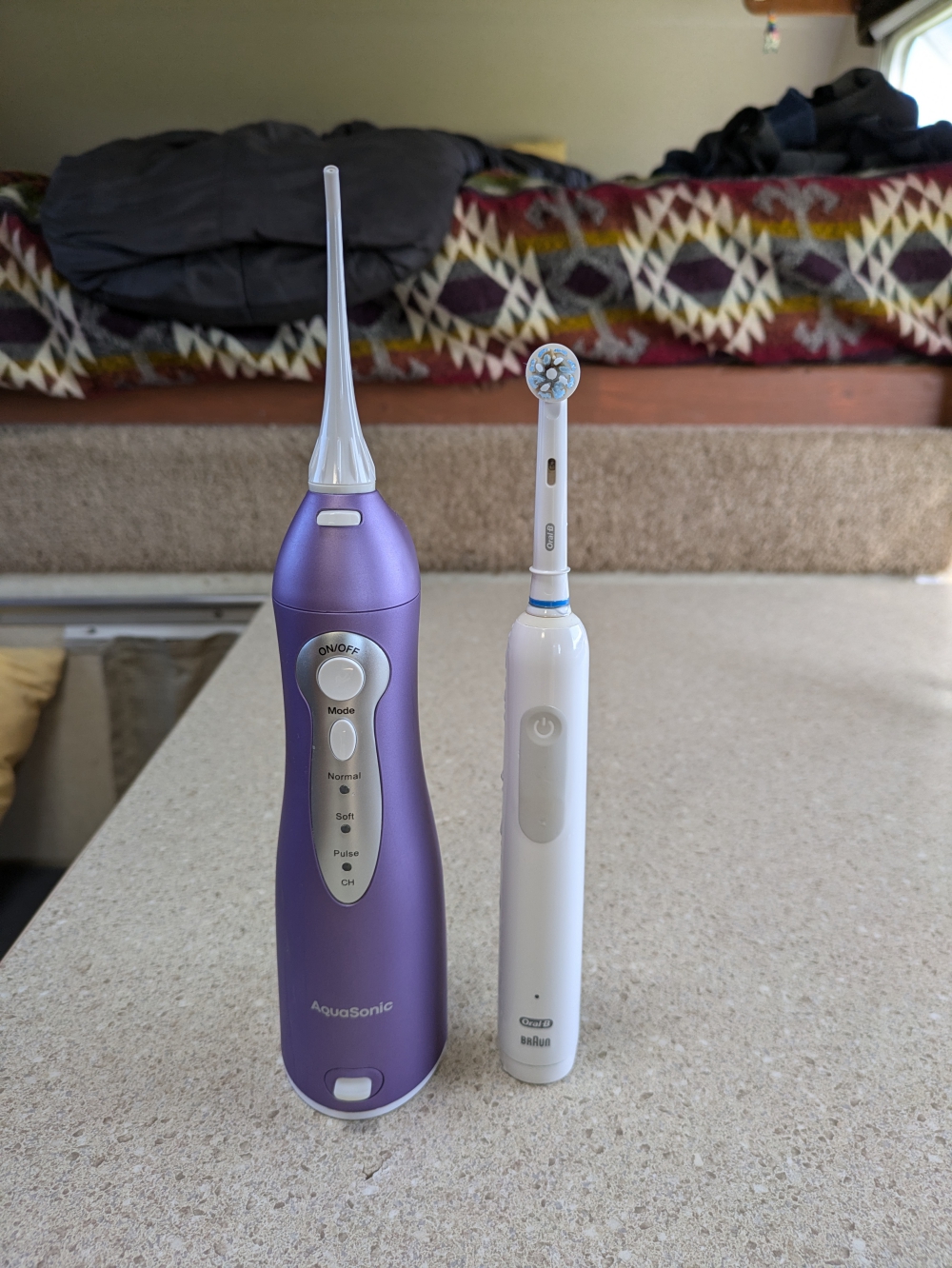
Water flosser and electric tooth brush to show the size difference
After the last procedure (the placement of the temporary crowns), I was in pain. First, my tongue was sore because of the rough edges of the crowns and my gums were super sensitive. Eating hurt but after a week, this got a bit better. I favored my left side to bite; the side with “only” two temporary crowns.
In Belgium, once the antibiotics regiment was done, the gum pain continued when eating and brushing and I experienced infection after infection. I still favored the left side of my mouth to chew until one of the temporary crowns cracked. Time to shift sides!
Eventually, I went to a dentist in Belgium to have antibiotics prescribed again. I kept up my new dental hygiene – three times brushing with an electric brush (carrying my manual one for days we were on the go), three times flossing with the water flosser, three times flossing with string, and using a dental pick for bigger gaps between my teeth and the tongue scraper out of habit. I took the advice of a friend and changed to Parodontax toothpaste as well. Once a day, I added mouth wash or a medicinal rinse for good measure.
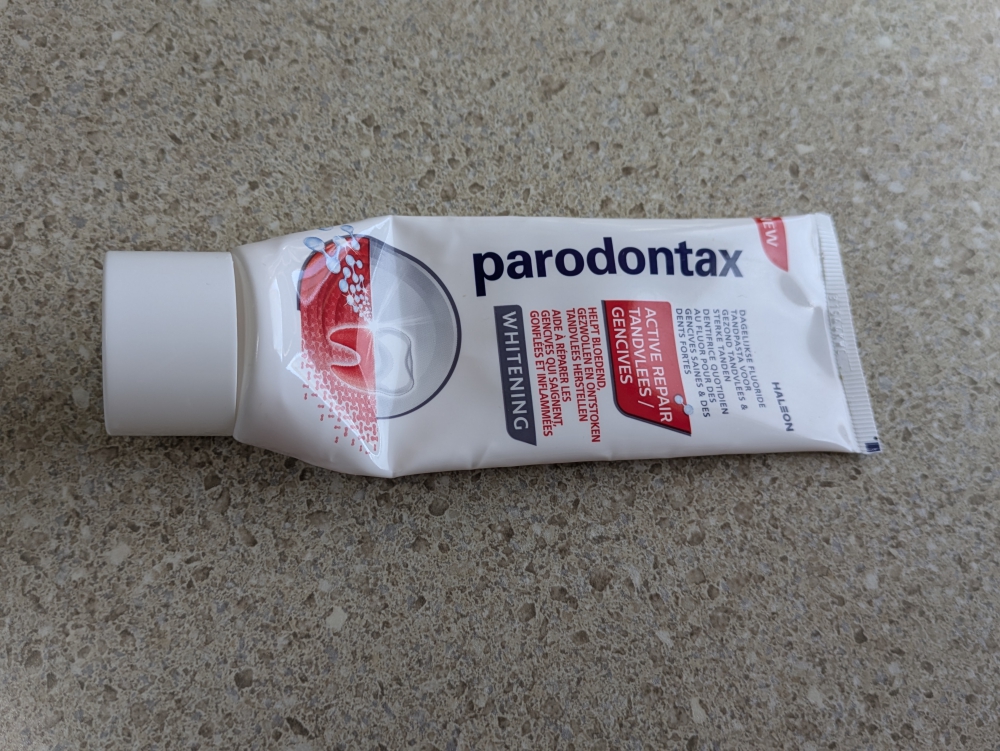
Parodontax tooth paste for gum repair – I stocked up on it through Amazon.
While enjoying my time in Belgium, I was – in a way – counting the days until the installation of my new crowns. This also meant going through root scaling of my entire mouth (four quadrants), of which I’d heard horror stories. My insurance had approved this procedure and due to a schedule change in our flight back to Argentina, we had managed to push our departure date from Boston out with one day. Thankfully. Timing would not have allowed the procedures otherwise.
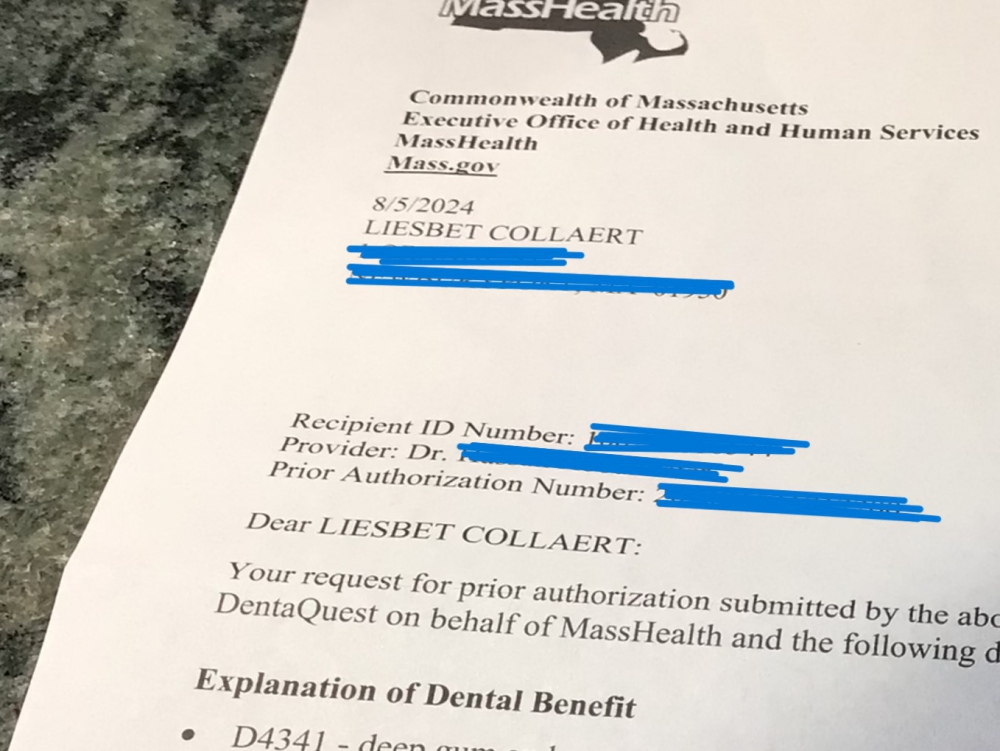
My MassHealth insurance approval for the root scaling procedures
So, back in Massachusetts, USA, I spent another two days at the dentist. I brought Belgian chocolates for the accommodating and helpful crew; they almost felt like family by then.
My new crowns were inserted (without sedation; another painful affair) and the left side of my mouth underwent part one of the root scaling procedure. For this, the dentist used local numbing and anesthesia. And he administered more antibiotics. I didn’t feel a thing! Not even after the numbness wore off. What about all those fearful, painful stories I’d heard?
The following day, the hygienist performed the root scaling on the other side of my mouth. Since I was doing okay with some local numbing, I never received Novocaine. Again, I was never in pain during or after this “scary” procedure. The dentist prescribed special toothpaste with extra Fluoride for my sensitive gums.
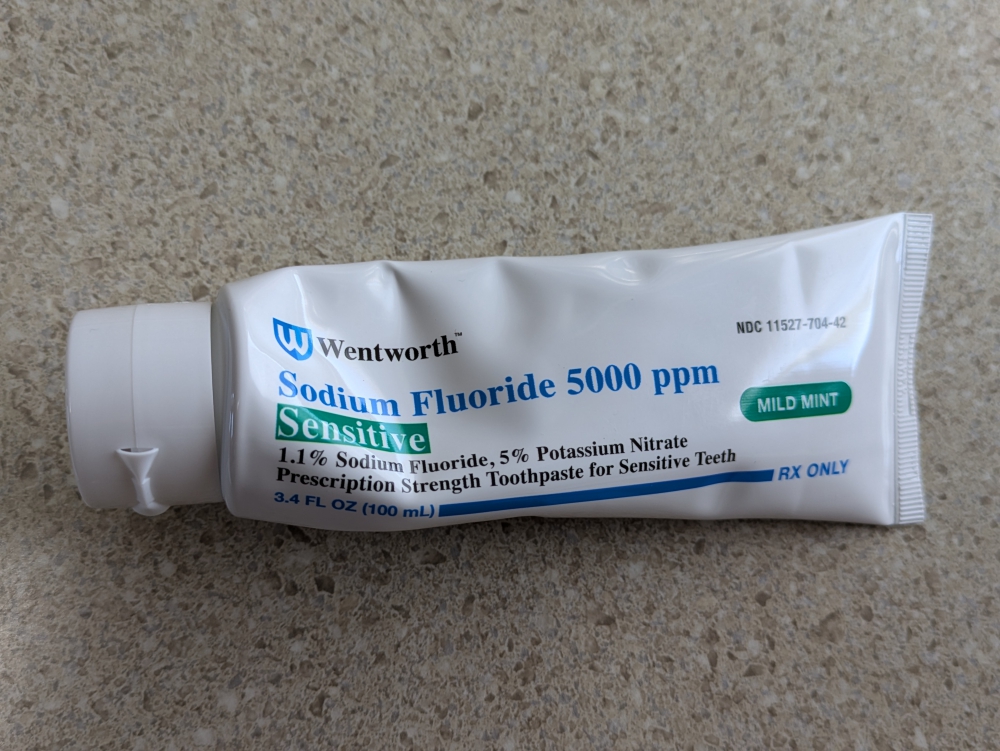
Prescription toothpaste for sensitive gums
But here is why I’m writing this blog: After my return from Belgium, following my new dental routine for two months, both the dentist and the hygienist were in awe. Based on my history and X-rays, they had expected some of my teeth to be loose or ready to fall out. That didn’t happen. Plus, they both commented on how the state of my gums had improved by leaps and bounds. They were firmer and some of the deep pockets had decreased a bit already. The miracle tool: a water flosser! And, possibly, the Parodontax toothpaste.
The future
The recommendation from my dental team: “Keep doing what you’re doing! It is helping.” And they want me to get quarterly cleanings. Finding local, professional, and qualified dental practices every three months might not be easy in South America, but I do plan to search for one twice a year.
I know dental care results, actions, and preferences are different for everyone, but I am very happy and impressed, hearing their diagnosis and prognosis for my teeth and gums!
While often inconvenient and always time consuming (three times a day for ten minutes), I do feel that my dental hygiene procedures help. So, I will try my best to keep them up. But continuing this routine is much harder in a camper with limited water, limited electricity, and a tiny bathroom sink! Especially regarding the water flosser. Because my gums are so sensitive – and they always will be, because bone loss is irreparable – I have to warm up water on the stove to fill the reservoir of the flosser, before using it. I miss my Belgian microwave!
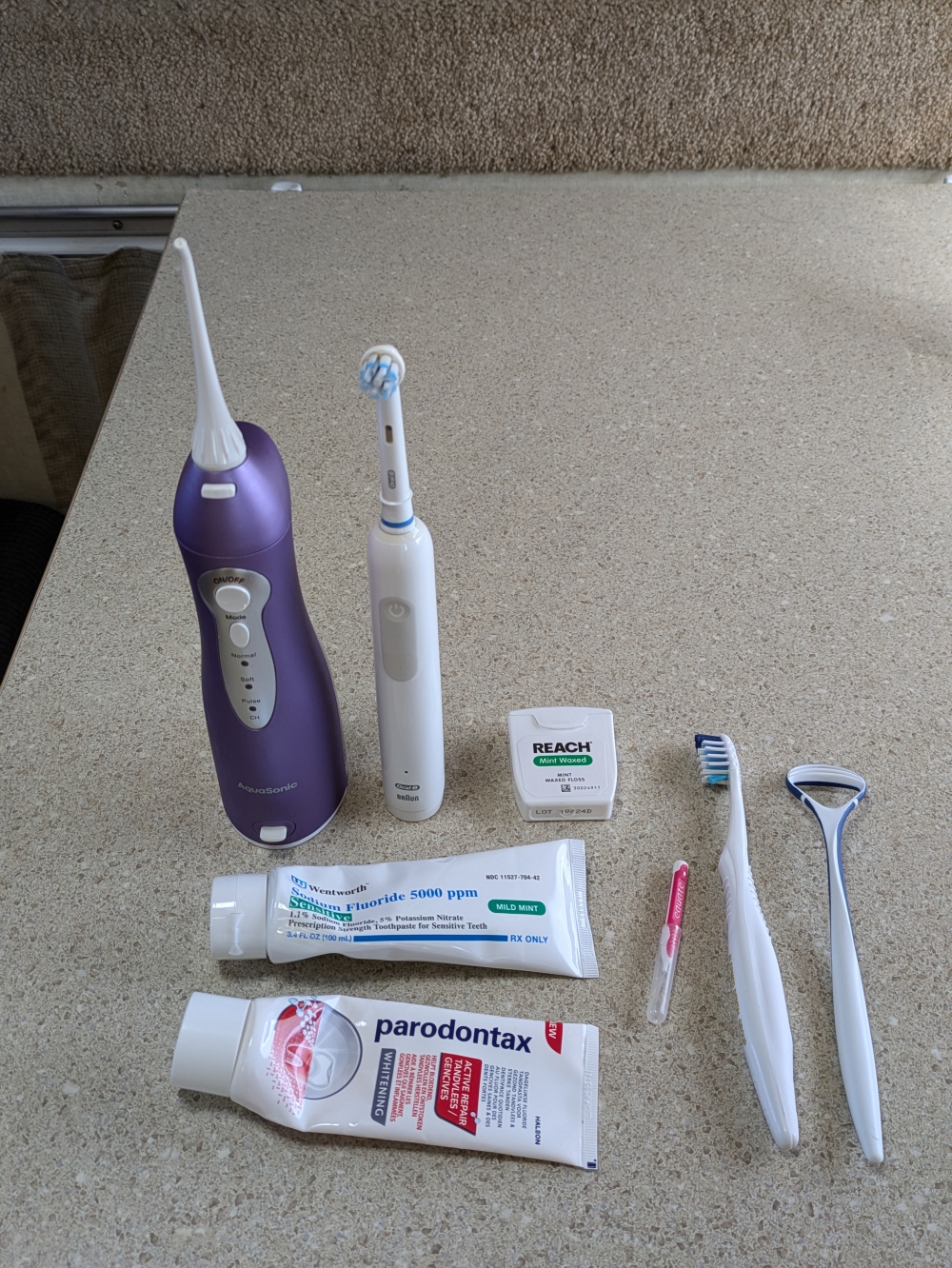
Dental hygiene items
(This post contains affiliate links at no extra cost for you, if you decide to buy anything.)
Next up: Our expense report for September 2024.
Curious about a previous ten-year chapter in our nomadic lives, which includes eight years aboard a 35-foot sailboat in the tropics with dogs, check out my compelling, inspiring, and refreshingly honest travel memoir:
Discover more from Roaming About
Subscribe to get the latest posts sent to your email.




















September 30, 2024 at 14:21
OMG!!!!!! What a story! I am just grabbing my mouth and holding tight. Thanks for the advice! Jim
September 30, 2024 at 18:58
Doesn’t everyone have a story like this? Keep holding on, Jim! 🙂
September 30, 2024 at 14:48
Did the dentist offer you numbing agents, or did you not take them for personal reasons? If they didn’t, that seems very irresponsible on their part. I was a lazy flosser for many years, meaning I did it occasionally. Now, it’s become a part of my daily routine and things have improved quite a bit. My gums and the dentist are happy with me. ????
September 30, 2024 at 19:04
That’s good news, Pete! A happy dentist means a lot. I used to think I did a good job with the flossing as well, but now I tend to doubt it. Of course, gum disease can be hereditary as well.
Yes, the dentist always said, ”Raise your left hand if it hurts too much and I’ll administer some sedation.” Thing is that I was used to all the pain during the cleanings. Also, on the eve of July 4th, I knew it would be a long night for the dental team, so I didn’t want to slow things down by having them administer Novacaine and having to wait until it set in.
During the installation of the crowns, I wanted to “save the numbing” for the next procedure, the scaling, and it was important that I felt the new crowns and how they worked together with my other teeth.
And, when the root scaling of the right side of my mouth happened, I was fine with just the local numbing and never had pain to warrant Novocaine.
September 30, 2024 at 14:51
This is a painful story with a happy ending. (Smile!)
At mid-life, gum problems emerged for me too, and I’ve had to get special treatments during checkups, so I can definitely sympathize.
You attack problems head-on and the dental hygiene story is a case in point. I’ve been in the dentist’s chair for very long sometimes, but I can’t imagine 3 hours.
You’ve been an A+ patient and now we’re benefiting from super advice. Thank you, Liesbet. 😀
September 30, 2024 at 19:08
Thanks for the A+ rating, teacher Marian! 🙂
I do think I’m a good dentist patient, with patience, confidence, and trust. But usually, my visits there aren’t as painful, haha. That being said, people close to me say that they can’t even keep their mouth open for half an hour, which is an issue at the dentist. Especially with so many things going wrong.
I’m glad you attacked your gum problems as well, since it can get really bad really fast. I never realized that. So, I had to do something. A lot of things. And, immediately. Not having enough time in the US made this entire episode a lot trickier!
September 30, 2024 at 14:54
Hi, Liesbet – I am so sorry that you went through all this. I also use an electric toothbrush, brush and floss regularly and visit my dentist every 6-8 months. But I am looking into a water flosser and parodontax right now!
September 30, 2024 at 19:12
Hello Donna,
Why am I not surprised that you are a fine dental hygiene performer? If your teeth and gums are in good shape, nothing else is needed, probably. I’m sure your dentist would recommend what’s necessary, but, of course, some changes don’t hurt!
Yeah, the entire dental episode put a bit of a shadow on my summer in Belgium and the US. But, it all had to happen. And, most likely, some of it will have to be repeated in the future.
September 30, 2024 at 17:03
Yikes! I have been fortunate with my teeth but that is slowly changing as I get older. Maybe a water flosser and electric brush are in my future.
I’m glad things worked out as well as they did. Your dentil team really went the extra mile for you. Still shaking my head about you having those procedures without numbing, though. What was your reason?
September 30, 2024 at 19:19
Hello Janis,
Yes, it sounds like you have been fortunate with your teeth. I know people who have had zero cavities in their life! And, they aren’t even rigorous when it comes to their dental hygiene. A lot of it is hereditary, like so many health things.
The dental team did indeed go the extra mile (and smile :)) to help me and I’m very grateful for that. They really did effort to fit me in and take care of me. If I would have stuck with my old, impersonal dental clinic, nothing would have probably happened within that short time frame.
Not getting the numbing in certain cases was related to those events. Because I had so little time to get everything done, I didn’t want to slow things down (like on the eve of July 4th) by getting Novacaine administered.
In another case, I needed to feel the new crowns once they were installed and having been numbed up during the prep work would have sabotaged that. Plus, right after the installation of the new crowns, I’d have my first root scaling and I wanted to “save” the numbing for that. I didn’t know which side they’d work on, so didn’t want to mess that up with asking for numbing on the opposite side.
Other times, I didn’t expect the procedures to be that painful and thought it wouldn’t take long. But it often did. So, there were different reasons for “getting on with it” without anesthesia.
September 30, 2024 at 17:21
Wow! What an ordeal. I too use one of those waterpiks. There was a learning curve as I sprayed water all over myself and the bathroom initially. ???? I’ll need to look into that toothpaste. Hopefully, it’s smooth sailing from now on.
September 30, 2024 at 19:21
Oh, I hear you about the learning curve of the water pick, Ingrid! Gosh. So many wet mirrors, ceilings, and clothes when I first used it. Especially since we “lived” in different places during the summer. A lot of water and wet towels are involved to gracefully use this tool! 🙂
If you look into the Paradontax toothpaste, you’ll see that there are many different kinds with different purposes. It’s not a cheap product, though. 🙁
September 30, 2024 at 17:26
Omg, ouch!
September 30, 2024 at 19:22
That’s right. Now I understand why people hate going to the dentist!
September 30, 2024 at 17:56
I spend way too much doctor time on my mouth, but it pales compared to this story. Yikes! I’m glad it all worked out.
September 30, 2024 at 19:23
Thanks, Jacqui. So far, I’m glad about the outcome as well, but this routine has to become a lifelong practice. I’m not looking forward to that. Brushing my teeth twice a day wasn’t a big deal in the past, now I often dread that extensive chore and I have to plan around the time it takes!
October 3, 2024 at 09:48
A jaw infection inspired me to floss regularly, swish with Listerine (and hydrogen peroxide), and pay better attention. So far, so good.
October 7, 2024 at 10:35
Good to hear, Jacqui! And, yikes, rinsing with hydrogen peroxide… It tastes awful. I used to swish with it as well, then changed to salt water. Then stopped all together when the infections disappeared.
September 30, 2024 at 18:08
That is horrifying! Crap, I hate going every six months, but I will keep at it (paid for by insurance) if it prevents something like that. And yeah, electric toothbrush all the way.
September 30, 2024 at 19:26
Hi Alex,
It’s so nice that your (and my) health insurance pays for twice-a-year teeth cleanings. It must mean that it’s needed for good dental hygiene. I never saw it that way. And I’m never in the US enough, but I think I’ll happily pay out of pocket when I get these cleanings abroad from now on. And, yes, the electric toothbrush seems to make a difference as well.
September 30, 2024 at 22:57
Hi Liesbet, I’m sorry that you had to go through all this. I’m glad to read that you’ve got good results from your new dental care routine. Keep up the good work to keep your teeth and gum healthy. Even though the dental care routine is time-consuming, it’s a lot less time-consuming and less expensive than the number of times you’d have had to see a dentist if you had lost your adult teeth.
October 1, 2024 at 14:48
Hi Natalie,
Yes, good point about sticking to the meticulous and time-consuming hygiene methods. I actually did lose an adult tooth many years ago (it got pulled in the Galapagos of all places), which required an implant ASAP, because bone loss goes fast and without enough bone, an implant is not possible anymore. A very expensive procedure I had done in Belgium. I don’t want to repeat that!
October 1, 2024 at 05:47
Hi Liesbet,
I have always been a bit nervous about going to the dentist, but I do make sure to have a yearly check up and also have a dental hygiene once a year. I have been using an electric toothbrush for years, I really like it. I have not heard of the waterpicks, must have a look into that.
I think it is worth investing in good dental health, my MIL has false dentures and they cause her so much pain and trouble sometimes. I would not fancy that. Keep up the good work ????
October 1, 2024 at 14:53
Hi Gilda,
Electric toothbrushes seem to be the preferred tool for a lot of people. Mark has been using one for years as well. I just didn’t feel like the hassle, time commitment, and extra gadgets needed if I weee to which. So, now I had to switch out of necessity, haha. Things are just harder in a camper. Or on a boat.
Water flossers exist in many different brands and budgets. They are much smaller now than they used to be, as they are portable and rechargeable. So, all in all, they can be practical enough, especially in a house.
And here I thought false dentures would be an easy and painless solution! 🙂
October 4, 2024 at 12:42
Wow, what an unpleasant shock for you to get news like that. Hooray that your new dental regimen is working, though! Years ago my original dentist recommended an electric toothbrush, and I switched then; but a few years ago I switched back to an ordinary toothbrush because I hated the noise of it and the wastefulness of the battery replacements. My current dentist says he’s happy with the way my brushing / flossing / mouthwash system is working, but your tale is a good reminder for me to stay diligent. (And to see the dentist regularly, just in case something changes!)
October 7, 2024 at 10:41
Hello Diane,
While most people I know have switched to an electrical toothbrush years ago, some hold strong to their manual one or switched back. I’m happy that our toothbrushes are rechargeable. Mark and I share the holder and the base and change out the heads before each use. This works for us in the camper. The noise is still annoying. Ours makes a special sound every 30 seconds, so we know how long we’ve been brushing. It also indicates when the obligatory 2 minutes have passed.
I’m glad you found a healthy routine – it is different for everyone – but the fact that almost 50% of adults have some form of gum (periodontal) disease is quite scary!
October 5, 2024 at 07:33
What a ‘sore’ and painful story, Liesbet. I can’t even begin to imagine what you went through with all that pain.
When I was a much younger man, I went without seeing a dentist for about six years! Big mistake! I ended up with bad toothache and then having to have surgery to remove two wisdom teeth. Since then, I’ve looked after my dental hygiene better, although still had issues. It wasn’t until I started using TePe Interdental brushes (to clean between my teeth) that things got much better. I did have a crown (that was over 20 years old) fall out and replaced at the beginning of the year, but it hasn’t given me any trouble.
It goes to show how important it is to visit a dentist (and dental hygienist) at least once a year (I go once every six months).
i hope you bought back some Belgian chocolates for yourself, too.
October 7, 2024 at 10:47
Hi Hugh,
As I reminded myself throughout all those dental procedures: the pain is temporary. I’m more bummed and annoyed at the lingering pain from my sensitive teeth and gums. I know that will never completely disappear…
Skipping dentist visits never seems to be a good idea. Luckily for you those were wisdom teeth that had to get pulled. I know quite a few people who – after multiple years of neglect – finally had to go to the dentist because of pain and infections and they had to get good teeth pulled. 🙁
I’m glad you have found a routine and approach that works for you. Those interdental brushes are a must when having bigger gaps between teeth. I use and reuse one of them as well for those areas. It seems that different methods combined give the best results.
We did bring some Belgian chocolate for ourselves – and it will last a while – but we have been sharing it with good friends we met up with again on the road, this last weekend.
October 8, 2024 at 15:31
So sorry. This is why I avoid the dentist (probably not a good idea). I’m glad your insurance approved.
October 9, 2024 at 20:04
Hi Duwan,
As you know, Mark and I are very fortunate and grateful about our MA health insurance. It’s why we want to keep our home base in that state and why we don’t mind paying taxes there. I’m still very happy with the care I received at that dentist and am trying to keep up my lengthy and complicated routine. Even with limited water and electricity. Maybe it’s time to go to a dentist? 🙂
October 9, 2024 at 14:06
I’m going through this gum thing right now. I’ve been electric brushing and water flossing for years. I may be up next for the bone scaling ouch! And why no numbing agents with all you went through? OUchee! <3
October 9, 2024 at 20:18
Oh no, Debby! Sorry to read about your gum disease. Yet, around 50% of adults suffer from this, so I’m surprised I don’t hear more about it from family and friends. The root scaling sounds worse than it is. Especially with Novocain it should be painless.
The reason I passed on numbing during a few of the procedures (the less serious ones) were diverse, from not wanting to waste more time for the dentist and his assistant, to needing to feel if the new crowns fit, to wanting to save the numbing for a more serious procedure that followed the first one to getting used to the pain and thinking I’d come this far without numbing that I might as well stick it out until the end. 🙂
October 10, 2024 at 10:14
Thanks for the info Liesbet. You are a real trooper my friend. 🙂
October 10, 2024 at 18:36
I’m just (a bit) crazy! 🙂